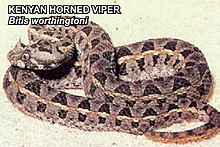Bitis worthingtoni
| Bitis worthingtoni | |
|---|---|

| |
| Scientific classification | |
| Domain: | Eukaryota |
| Kingdom: | Animalia |
| Phylum: | Chordata |
| Class: | Reptilia |
| Order: | Squamata |
| Suborder: | Serpentes |
| Family: | Viperidae |
| Genus: | Bitis |
| Species: | B. worthingtoni
|
| Binomial name | |
| Bitis worthingtoni | |

| |
Bitis worthingtoni, also known commonly as the Kenya horned viper[1][4] and the Kenyan horned viper,[5] is a species of venomous snake in the subfamily Viperinae of the family Viperidae. The species is endemic to Kenya.[1][4] There are no subspecies that are recognized as being valid.[4][6]
Etymology[edit]
The specific name, worthingtoni, is in honor of British zoologist Edgar Barton Worthington,[5] collector of the first specimen.[4]
Common names[edit]
Common names for B. worthingtoni include Kenya horned viper[1][4][7][8] and Kenyan horned viper.[5]
Description[edit]
B. worthingtoni usually grows to a total length (including tail) of 20 to 40 cm (7.9 to 15.7 in), with a maximum total length of 50 cm (20 in).[7][8]
Geographic range and habitat[edit]
The preferred natural habitats of B. worthingtoni are grassland, rocky areas, savanna, and shrubland.[1] B. worthingtoni is restricted to Kenya's high central Rift Valley[3][7] at elevations of 1,500–2,500 metres (4,900–8,200 ft).[1] The type locality given for B. worthingtoni is the "shore of Lake Naivasha [Kenya]".[3][7]
Reproduction[edit]
B. worthingtoni is viviparous.[4]
Conservation status[edit]
In 2004, a proposal was submitted by Kenya to have B. worthingtoni listed on CITES Appendix II. The actual status of the species was unknown, but it was reasoned that the Kenyan proposal was justified due to the species' restricted geographic range, habitat loss, demand by reptile collectors and the existence of illegal trade.[9] In 2019, B. worthingtoni was listed as "Vulnerable" by the International Union for Conservation of Nature.[1]
References[edit]
- ^ a b c d e f g Spawls, S.; Malonza, P.K. (2019). "Bitis worthingtoni". IUCN Red List of Threatened Species. 2019: e.T22473714A22473718. doi:10.2305/IUCN.UK.2019-2.RLTS.T22473714A22473718.en. Retrieved 19 November 2021.
- ^ "Appendices | CITES". cites.org. Retrieved 2022-01-14.
- ^ a b c McDiarmid RW, Campbell JA, Touré T (1999). Snake Species of the World: A Taxonomic and Geographic Reference, Volume 1. Washington, District of Columbia: Herpetologists' League. 511 pp. ISBN 1-893777-00-6 (series). ISBN 1-893777-01-4 (volume).
- ^ a b c d e f Bitis worthingtoni at the Reptarium.cz Reptile Database. Accessed 3 February 2022.
- ^ a b c Beolens B, Watkins M, Grayson M (2011). The Eponym Dictionary of Reptiles. Baltimore: Johns Hopkins University Press. xiii + 296 pp. ISBN 978-1-4214-0135-5. (Bitis worthingtoni, p. 289).
- ^ "Bitis worthingtoni". Integrated Taxonomic Information System. Retrieved 3 February 2022.
- ^ a b c d Mallow D, Ludwig D, Nilson G (2003). True Vipers: Natural History and Toxinology of Old World Vipers. Malabar Florida: Krieger Publishing Company. 359 pp. ISBN 0-89464-877-2.
- ^ a b Spawls S, Branch B (1995). The Dangerous Snakes of Africa. Dubai: Ralph Curtis Books. Oriental Press. 192 pp. ISBN 0-88359-029-8.
- ^ "Bitis worthingtoni ". CoP13 at Species Survival Network. Accessed 8 October 2006.
Further reading[edit]
- Fleck J (2003). "Bemerkungen zur Kenia-Hornpuffotter, Bitis worthingtoni, sowie Beobachtungen bei der Haltung und Vermehrung [= Comments on the Kenya puff adder, Bitis worthingtoni, with observations on its care and breeding]". Elaphe 8 (3): 20-23. (in German).
- Parker HW (1932). "Scientific results of the Cambridge Expedition to the East African Lakes, 1930–1. — 5. Reptiles and Amphibians". Journal of the Linnean Society of London, Zoology 38: 213-229. (Bitis worthingtoni, new species, p. 221).
- Spawls S, Howell K, Hinkel H, Menegon M (2018). Field Guide to East African Reptiles, Second Edition. London: Bloomsbury Natural History. 624 pp. ISBN 978-1472935618. (Bitis worthingtoni, p. 581).

